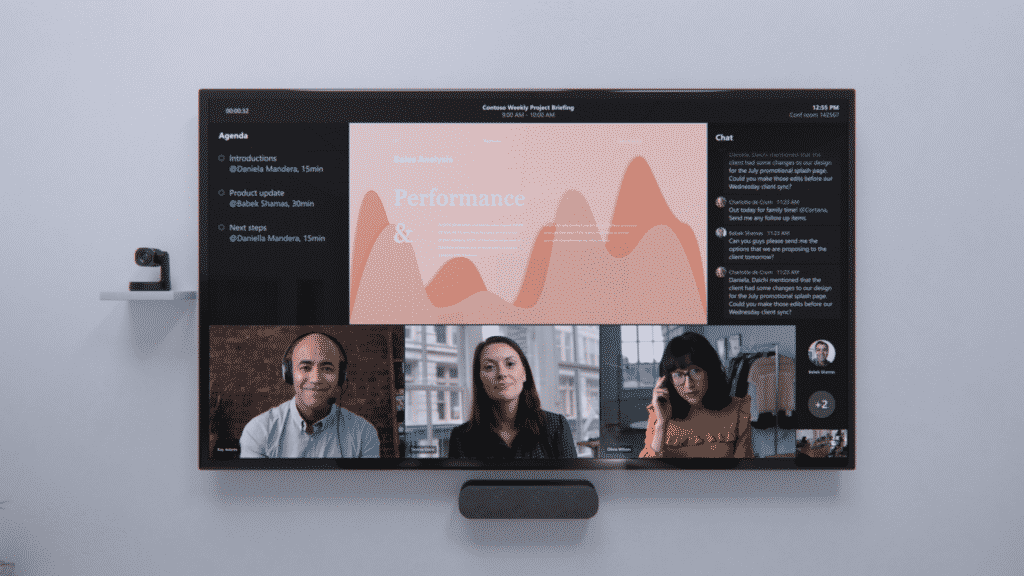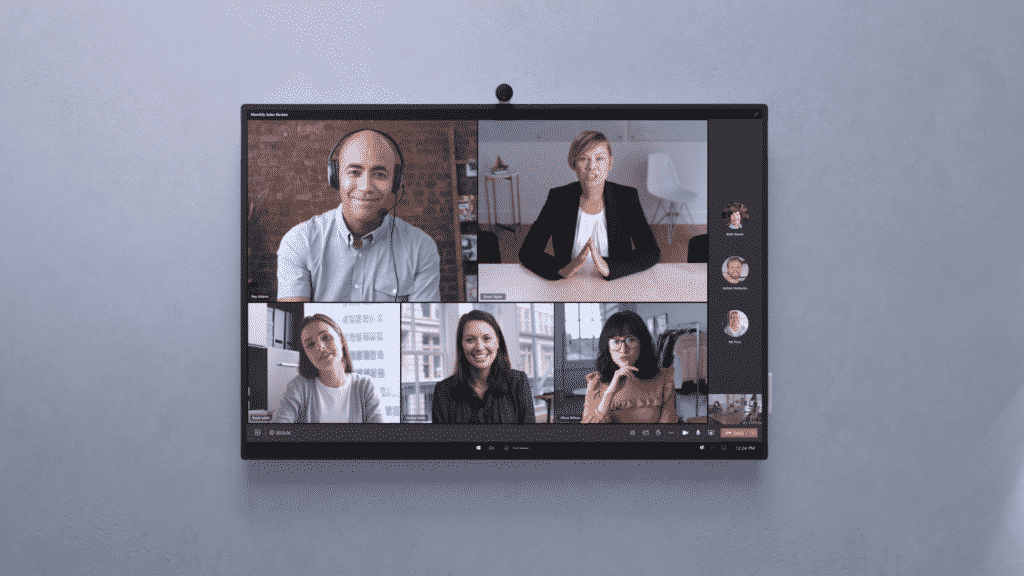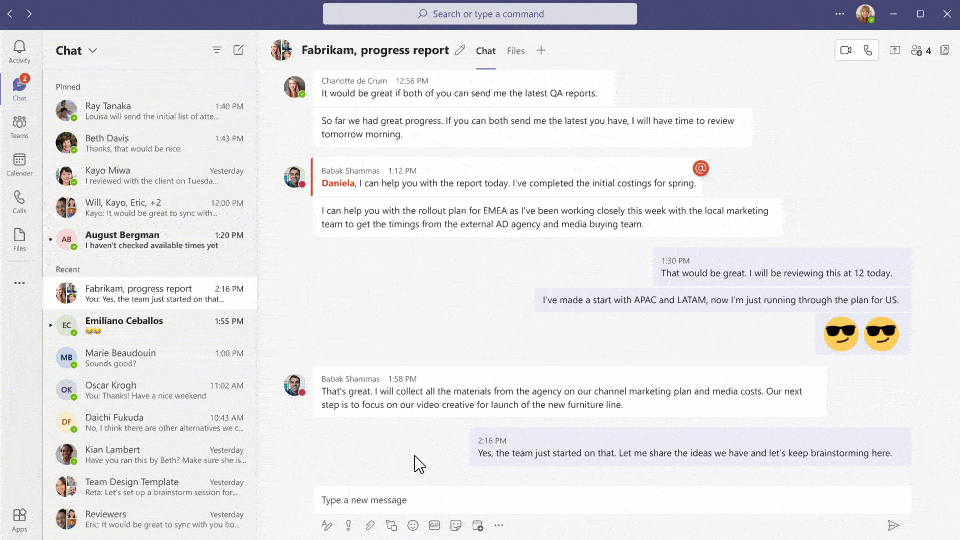As workplaces open in many regions around the world, I hear from customers every day that they can’t wait to get back to in-person collaboration. I feel it myself—and look forward to seeing many of my coworkers in person one day soon. But even more than that, I look forward to finding new ways to help people connect and engage regardless of location and time zone. At Microsoft, we believe that hybrid work is the future of work and that to empower their people to succeed in hybrid work, business leaders will need to reimagine their organizations with a new operating model for people, places, and processes.
We’re also committed to building experiences that put everyone on equal footing—whether they’re together in a conference room in Atlanta, presenting remotely from a home office, or catching up with a meeting recording once the workday begins in Sydney.
Microsoft Teams is mission-critical to this vision for a more flexible world of work. Teams is unique in that it brings together meetings, chat, calls, collaboration, and business process automation in a single app. Since COVID-19 spurred office workers around the world to work from home, we’ve been innovating in Teams to do things like create more natural and engaging meeting experiences—enable people to connect seamlessly with those inside and outside of their organizations and provide ways to make remote presentations richer and more impactful. And as we emerge into this new hybrid reality, we are focused on building experiences in Teams that are designed to ensure all voices are heard including the people not in the room—empowering everyone to connect and engage, from anywhere and at any time. And to make it easier to collaborate synchronously and asynchronously, we’re also announcing new Microsoft Fluid canvas innovations—in Teams and beyond.
But COVID-19 also taught us that meeting fatigue and digital overload is real, and remote work has challenged our wellbeing. To help, Microsoft has built Microsoft Viva—our integrated employee experience platform—into Teams, so that employees can find ways to protect time and preserve their wellbeing right in the flow of their work.
Today we are announcing new innovations—in Microsoft Teams Rooms, Fluid, and Microsoft Viva—all designed to empower your people for hybrid work. Let’s have a look.
Participate on equal footing—at home, onsite, or on the go #
Unlocking better hybrid meeting experiences for everyone begins with designing for the people who aren’t in the room, so that everyone feels like they have a seat at the table, whether they’re joining in the room, at home, or on the go. Today, we’re announcing enhancements to Teams meetings and Microsoft Teams Rooms built to create engaging experiences for every participant.
Over the course of this year, we will roll out front row in Teams Rooms, an immersive room layout that makes interactions feel more natural and gives in-room participants a greater sense of connection to remote participants. We’ve moved the video gallery to the bottom of the screen so remote participants are face-to-face with those in the room. And to help everyone stay engaged, meeting content is surrounded by contextual meeting information like the agenda, tasks, and notes. Meeting chat will also be clearly visible to those in the room, so they can see and respond to comments shared through chat.

To help remote participants establish their presence in the room and maximize inclusion, Teams Rooms will expand screen real estate using new video layouts that disperse the video gallery across multiple displays when content isn’t shared. The increased space means remote participants show up larger and more true to life. We’re also bringing more features from desktop to Teams Rooms this summer, to help bring attention to the remote participants engaging in the meeting. These features include live reactions, spotlight, and the ability to pin multiple video streams (coming this fall) and chat bubbles when using the classic video grid layout.

Remote participants should also be able to see who is in the meeting room, and what’s happening. Jabra, Logitech, Poly, and our newest Teams device partner Neat are using advanced AI-powered camera technologies to provide new video views optimized for hybrid meetings, allowing every person in the room to be seen more clearly.
We’re also making sure those who speak in meetings are clearly identified. The Teams intelligent speakers from EPOS and Yealink are now generally available and are built for Teams Rooms and use Microsoft’s voice recognition technology in Teams to attribute remarks to the meeting room speaker in the transcript. With speaker attributed—meeting transcription, people can focus on contributing to the conversation instead of taking notes, and those who missed the meeting can see a record of the conversation after the meeting.
And we’re thrilled to announce the new Teams Rooms on Surface Hub experience. Surface Hub is purpose-built for teams to meet and co-create, wherever they work, and the next generation of Teams on Surface Hub brings more of your favorite meetings features and controls from the desktop to the meeting room—including a modernized meeting stage, Together Mode scenes, and PowerPoint Live. Coming this fall, the new Microsoft Whiteboard experience will also be available on Surface Hub, so everyone can draw and ink on the same digital canvas.
You can find more information on these Teams Rooms and partner announcements on our Teams Tech Community Blog.

To empower remote participants to initiate and facilitate whiteboard sessions, we’ve created a completely new, hybrid work-focused Whiteboard experience where all attendees can visually collaborate across the same digital canvas. Available in summer 2021, new features will enable anyone to bring existing content to Whiteboard to co-author; and new templates will help groups start ideating faster, improving their ability to follow along with contributors, and more.
Effective hybrid meetings require every participant to be able to present, and experience a presentation in a way that’s engaging and inclusive. New PowerPoint Live features help create a shared space for collaboration and contributions from everyone in the meeting. Slide translate allows attendees to see the presentation in their chosen language, for instance. And with our new inking experience, you can annotate your PowerPoint as you present—or use a laser pointer to call attention to key points.
And look for these latest features in the Teams mobile app as well. You can now access PowerPoint Live and Dynamic view on your mobile devices. Custom background is also now on iOS and coming soon to Android.
Collaborate in the flow of work #
To work effectively in hybrid and asynchronous models, people need a super-rich canvas that both creates and maintains context before, during, and after the meeting. Fluid components are atomic units of productivity that help you get your work done in the context of chat, emails, meetings, and more. Recently, we announced new Fluid components in chat to create live, collaborative experiences that can be edited in real-time and shared across Teams and Office apps. And today, we’re announcing the expansion of Fluid components for Teams meetings, OneNote, Outlook, and Whiteboard that make it easier to collaborate synchronously and asynchronously across Teams and Office apps. We’re also announcing new chat features that further support asynchronous collaboration, so you can keep the work moving forward in between meetings. Pin a message, providing your chat members with quick access to critical content anytime, and reply to a specific chat message maintaining context within the ongoing conversation.

Meetings have increased significantly over the past year, along with unstructured communications. Research from our Work Trend Index shows the average Teams user is sending 45 percent more chats per person per, week than they did one year ago. And ad-hoc, unstructured meetings are on the rise as well. To help manage this digital overload, new Fluid components in Teams meetings make it easy to co-create an agenda, take notes, and assign tasks, right within the Teams meeting, and access persistent recap content whenever you need it. And the note, agenda, and tasks from meetings will be automatically “placed” in the new meeting notes home of OneNote. While the meeting is underway, take the discussion a step further by ideating and brainstorming together by creating and editing live Fluid components in Whiteboard. Fluid components can also be leveraged across Outlook—in email or the calendar—making it easier to manage your time, agenda, notes, and tasks across apps.
Protect time and prioritize wellbeing.
Weekly meeting time for Teams users has more than doubled since the onset of the COVID-19 pandemic. Back-to-back meetings increase stress and make it harder to stay engaged and focused. In just a few minutes a day, meditation and mindfulness with Headspace can help you reduce stress and improve focus. Starting later this month, we’re bringing a curated set of guided meditations and mindfulness exercises from Headspace to the Viva Insights app in Teams to help you start your day grounded, relax your mind before a big presentation, or disconnect from work in the evening.
Building upon the Viva Insights ability to schedule daily focus time to work uninterrupted with Teams notifications silenced, we are introducing a new focus mode in the Viva Insights app later this year. This will feature Focus music from Headspace and implement timers to help you make progress on important tasks in regular intervals with breaks planned in between.


As we all navigate this new world of work together, we will discover new ways to help people work both flexibly and effectively. At Microsoft, we’re committed to bringing you experiences that empower people to work from anywhere, at any time. By studying the research and the usage patterns in our apps—and talking to customers every day—we are continuing to hone our understanding of what people need, to bring their best selves to work every day. This understanding guides our innovation as we work to bring you and your people experiences that help them achieve more.





